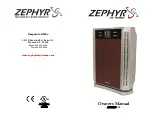
58
EconoMi$er IV Troubleshooting Completion
This procedure is used to return the EconoMi$er IV to operation.
No troubleshooting or testing is done by performing the
following procedure.
1. Disconnect power at TR and TR1.
2. Set enthalpy potentiometer to previous setting.
3. Set DCV maximum position potentiometer to previous
setting.
4. Set minimum position, DCV set point, and exhaust
potentiometers to previous settings.
5. Remove 620-ohm resistor from terminals S
R
and +.
6. Remove 1.2 kilo-ohm checkout resistor from terminals S
O
and +. If used, reconnect sensor from terminals S
O
and +.
7. Remove jumper from TR to N.
8. Remove jumper from TR to 1.
9. Remove 5.6 kilo-ohm resistor from T and T1. Reconnect
wires at T and T1.
10. Remove jumper from P to P1. Reconnect device at P and
P1.
11. Apply power (24 vac) to terminals TR and TR1.
Table 35—Cooling Service Analysis
PROBLEM
CAUSE
REMEDY
Compressor and Condenser Fan
Will N S
Power failure.
Call power company.
Compressor and Condenser Fan
Will Not Start.
Fuse blown or circuit breaker tripped.
Replace fuse or reset circuit breaker.
Defective thermostat, contactor, transformer, or
control relay.
Replace component.
Insufficient line voltage.
Determine cause and correct.
Incorrect or faulty wiring.
Check wiring diagram and rewire correctly.
Thermostat setting too high.
Lower thermostat setting below room temperature.
Compressor Will Not Start
But Condenser Fan Runs.
Faulty wiring or loose connections in compres-
sor circuit.
Check wiring and repair or replace.
But Condenser Fan Runs.
Compressor motor burned out, seized, or in-
ternal overload open.
Determine cause. Replace compressor.
Defective run/start capacitor, overload, start
relay.
Determine cause and replace.
One leg of 3-phase power dead.
Replace fuse or reset circuit breaker. Determine
cause.
Compressor Cycles (Other Than
Normally Satisfying Thermostat).
Refrigerant overcharge or undercharge.
Recover refrigerant, evacuate system, and recharge
to nameplate.
Normally Satisfying Thermostat).
Defective compressor.
Replace and determine cause.
Insufficient line voltage.
Determine cause and correct.
Blocked condenser.
Determine cause and correct.
Defective run/start capacitor, overload, or start
relay.
Determine cause and replace.
Defective thermostat.
Replace thermostat.
Faulty condenser-fan motor or capacitor.
Replace.
Restriction in refrigerant system.
Locate restriction and remove.
Compressor Operates Continuously.
Dirty air filter.
Replace filter.
Compressor Operates Continuously.
Unit undersized for load.
Decrease load or increase unit size.
Thermostat set too low.
Reset thermostat.
Low refrigerant charge.
Locate leak, repair, and recharge.
Leaking valves in compressor.
Replace compressor.
Air in system.
Recover refrigerant, evacuate system, and recharge.
Condenser coil dirty or restricted.
Clean coil or remove restriction.
Excessive Head Pressure.
Dirty air filter.
Replace filter.
Excessive Head Pressure.
Dirty condenser coil.
Clean coil.
Refrigerant overcharged.
Recover excess refrigerant.
Air in system.
Recover refrigerant, evacuate system, and recharge.
Condenser air restricted or air short-cycling.
Determine cause and correct.
Head Pressure Too Low.
Low refrigerant charge.
Check for leaks, repair, and recharge.
Head Pressure Too Low.
Compressor valves leaking.
Replace compressor.
Restriction in liquid tube.
Remove restriction.
Excessive Suction Pressure.
High heat load.
Check for source and eliminate.
Excessive Suction Pressure.
Compressor valves leaking.
Replace compressor.
Refrigerant overcharged.
Recover excess refrigerant.
Suction Pressure Too Low.
Dirty air filter.
Replace filter.
Suction Pressure Too Low.
Low refrigerant charge.
Check for leaks, repair, and recharge.
Metering device or low side restricted.
Remove source of restriction.
Insufficient evaporator airflow.
Increase air quantity. Check filter and replace if neces-
sary.
Temperature too low in conditioned area.
Reset thermostat.
Outdoor ambient below 25 F.
Install low-ambient kit.
Evaporator Fan Will Not Shut Off.
Time off delay not finished.
Wait for 30-second off delay.
551B
,C




































